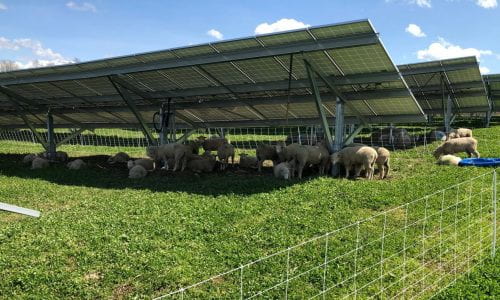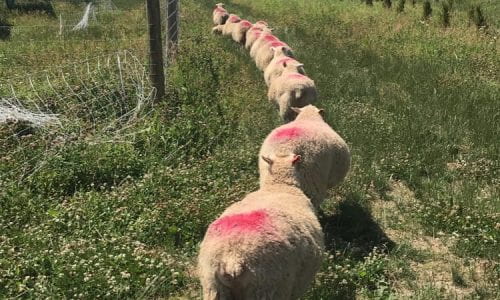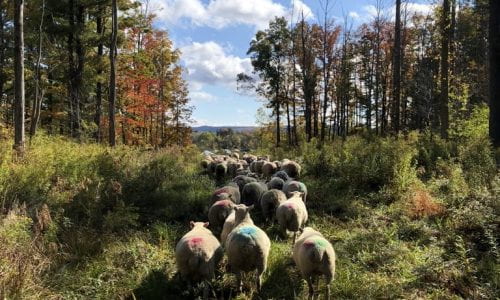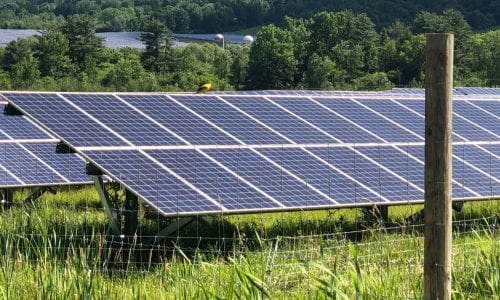In December 2020, a total of 659 individual, constructed and fenced acres of ground mounted photovoltaics (PV) < 20 MW were installed or in the pipeline in NY with an output of 2,874.4 MW [1, 2]. With an estimated 6 acres per MW [3], these projects occupy ~17,245 acres. Additionally, 132 Utility Scale Solar Energy facilities (USSE) > 20 MW, potentially occupying a land area of 68,878 acres [2] and producing 11,479.6 MW, may start going online by 2023.
To avoid panel shading and the consequent reduced electricity production or panel damage, the vegetation within these solar arrays must be maintained. This can be done either by mechanical landscaping methods or with grazing sheep flocks.
Solar grazing is the practice of grazing livestock on a solar array. Sheep are the best-suited livestock species for solar grazing as they are small enough to control vegetative growth underneath the solar panels and will not damage the solar installations by chewing cables or jumping on panels.
Grazing sheep fulfill a clear purpose within these powerplants, while simultaneously increasing farm income and financial viability through vegetation management income (up to $500 per acre in NY State) and reducing entry barriers for young and beginning farmers interested in sheep enterprises: Investment costs for sheep grazing are lower than for other pasture management systems, especially with perimeter fencing already in place.
The sheep benefit from this arrangement as the solar panels offer shade and shelter from the elements and solar sites are fenced in, thus protecting the flock from predators.
Sheep grazing on solar arrays and well managed, extensive, and perennial pastures provide a sustainable option for vegetation control, offering a variety of ecosystem services. These benefits are currently being investigated and quantified by research at Cornell University:
- Maintenance of biodiverse pasture with a high proportion of native vegetation, providing diverse habitat for mammals, reptiles, birds, and insects.
- Establishment of flowering habitat for bee pollinators that can be maintained in rotational grazing systems, as well as habitat for predatory insects helping with pest-control on adjacent crop acreage.
- Increased soil health and soil carbon accrual and sequestration.
Land leases of 25+ years for solar installations offer the opportunity for long-term best management practices that will maintain highly diverse pastures in grazing systems, provide flowering habitat for bees (of conservation concern), and sequester soil carbon while increasing financial viability of sheep farmers and access to locally produced meat for communities.
Grazing solar sites with sheep and realizing these potential ecosystem services and benefits will place ruminant animal agriculture at the forefront of being part of the solution to mitigate climate change, habitat decline, and externalities created by land-use change.
References
[1] New York State Energy Research and Development Authority. 2020. https://data.ny.gov/Energy-Environment/Solar-Electric-Programs-Reported-by-NYSERDA- Beginn/3x8r-34rs , accessed December 12, 2020.
[2] New York Independent Systems Operator. 2020. https://www.nyiso.com/interconnections , accessed December 12, 2020.
[3] Suncyclopedia. 2020. http://www.suncyclopedia.com/en/area-required-for-solar-pv-power-plants/ . Accessed December 29, 2020.
google8ba0825189124a2a.html






